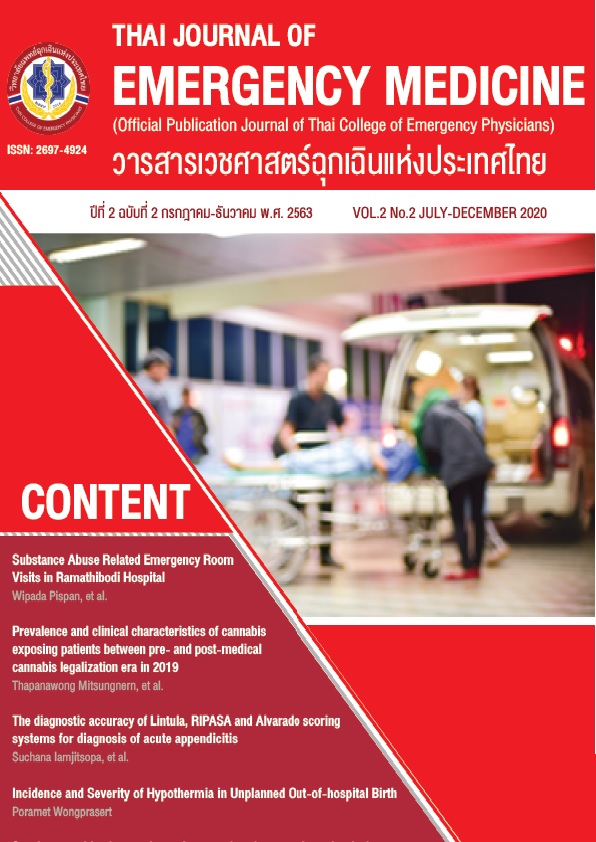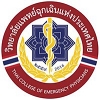Sepsis recognition in caregivers: A comparison between time of arrival to an emergency department and clinical outcomes of patients in Somdech Phra Pinklao hospital
Keywords:
Sepsis, Time-to-Treatment, MorbidityAbstract
Introduction : Sepsis can cause morbidity and mortality if it is not treated properly. Time to treatment has been found to affect the severity and mortality of sepsis in previous research. However, there have been no studies comparing arrival time to clinical outcome.
Objectives : Compare the length of sepsis patients' symptoms to the morbidity and mortality of patients brought to the emergency department.
Methods : A descriptive retrospective study, Somdej Phra Pinklao Hospital.
Results : 288 patients with sepsis from medical records. The baseline characteristics of the patients were not different. The duration of symptoms had no effect on morbidity (mean 1,440 and 1,940 minutes in non-morbidity and morbidity groups, respectively, p-value 0.061) and mortality (mean 1,440 and 1,440 minutes in non-mortality and mortality groups,respectively, p-value 0.414). However, the following factors were found to increase morbidity and mortality, including altered mental status (30.65% and 42.68% in non-morbidity and morbidity groups, respectively, p-value 0.037) (30.84% and 56.76% in non-mortality and mortality groups, respectively, p-value <0.001) shortness of breath(19.35% and 40.85% in non-morbidity group and morbidity groups, respectively, p-value<0.001) (28.04% and 41.89% in non-mortality and mortality groups, respectively, p-value<0.027). In contrast, factors that reduce the risk were fever or chills (70.16% and 50.61% in non-morbidity and morbidity groups, respectively, p-value 0.001) (65.42%6 and 40.54% in non-morbidity group and mortality groups, respectively, p-value <0.001)
Conclusion : The duration of symptoms did not affect the clinical outcomes, however fever or chills did lower the risk. Shortness of breath and altered mental status both increased the risk of sepsis and mortality.
References
Vincent JL. The Clinical Challenge of Sepsis Identification and Monitoring. PLoS Med.2016 05,13(5):e1002022.
Centers of Disease Control and Prevention. Sepsis [Internet]. Georgia; 2019 [cited 2019 Oct 28]. Available from: https://www.cdc.gov/sepsis/index.html
Angkasekwinai N,Rattanaumpawan P, Tham-likitkul V. Epidemiology of sepsis in Siriraj Hospital 2007. J Med Assoc Thai. 2009 ;92 Suppl 2:568-78.
Bunyaphatkun P, Sindhu S, Davidson PM,Utriyaprasit K, Viwatwongkasem C, Chart-bunchachai W. Factors Influencing Clinical Deterioration in Persons with Sepsis. PRUNR. 2017 21(2):135-47.
Kuhn FP, Mika M, Schild H, Klose K. [Sono-graphic spectrum of lateral head and neck soft tissue]. Rofo. 1983 Apr;138(4):435-9.
Govorovich EA, Elagina LV. [Effect of monomycin and neomycin on secretion and chemical composition of gastric juice in dogs at different conditions of central nervous system]. Antibiotiki. 1966 ;11(7):631-6.
Churpek MM, Snyder A, Han X, Sokol S, Pettit N, Howell MD, et al. Quick Sepsis-related Organ Failure Assessment, Systemic Inflammatory Response Syndrome, and Early Warning Scores for Detecting Clinical Deterioration in Infected Patients outside the Intensive Care Unit. Am J Respir Crit Care Med. 2017 04 1;195(7):906-11.
Harimtepathip P, Lee JR, Griffith E, Williams G, Patel RV, Lebowitz D, et al. Quick Sepsis-related Organ Failure Assessment Versus Systemic Inflammatory Response Syndrome Criteria for Predicting Organ Dysfunction and Mortality. Cureus. 2018;10(10):e3511.
Lim WT, Fang AH, Loo CM, Wong KS, Balakrishnan T. Use of the National Early Warning Score (NEWS) to Identify Acutely Deteriorating Patients with Sepsis in Acute Medical Ward. Ann Acad Med Singap. 2019;48(5):145-9.
Redfern OC, Smith GB, Prytherch DR, Meredith P, Inada-Kim M, Schmidt PE. A Comparison of the Quick Sequential (Sepsis-Related) Organ Failure Assessment Score and the National Early Warning Score in Non-ICU Patients With/Without Infection. Crit Care Med. 2018 12;46(12):1923-33.
Askim Å, Moser F, Gustad LT, Stene H, Gundersen M, Åsvold BO, et al. Poor performance of quick-SOFA (qSOFA) score in predicting severe sepsis and mortality - a prospective study of patients admitted with infection to the emergency department. Scand J Trauma Resusc Emerg Med. 2017;25(1):56.
Lo RSL, Leung LY, Brabrand M, Yeung CY, Chan SY, Lam CCY, et al. qSOFA is a Poor Predictor of Short-Term Mortality in All Patients: A Systematic Review of 410,000 Patients. J Clin Med. 2019 ;8(1):E61.
Seymour CW, Liu VX, Iwashyna TJ, Brunkhorst FM, Rea TD, Scherag A, et al. Assessment of Clinical Criteria for Sepsis: For the Third International Consensus Definitions for Sepsis and Septic Shock (Sepsis-3). JAMA. 2016;315(8):762-74.
de Montmollin E, Annane D. Year in review 2010: Critical Care--Multiple organ dysfunction and sepsis. Crit Care. 2011;15(6):236.
Blanco J, Muriel-Bombín A, Sagredo V, Taboada F, Gandía F, Tamayo L, et al. Incidence, organ dysfunction and mortality in severe sepsis: a Spanish multicentre study.Crit Care. 2008;12(6):R158.
Sakr Y, Lobo SM, Moreno RP, Gerlach H, Ranieri VM, Michalopoulos A, et al. Patterns and early evolution of organ failure in the intensive care unit and their relation to outcome. Crit Care. 2012 ;16(6):R222.
Bilevicius E, Dragosavac D, Dragosavac S, Araújo S, Falcão AL, Terzi RG. Multiple organ failure in septic patients. Braz J Infect Dis. 2001;5(3):103-10.
Ferreira FL, Bota DP, Bross A, Mélot C, Vincent JL. Serial evaluation of the SOFA score to predict outcome in critically ill patients. JAMA. 2001;286(14):1754-8.
Charlson ME, Pompei P, Ales KL, MacKenzie CR. A new method of classifying prognostic comorbidity in longitudinal studies: development and validation. J Chronic Dis.1987;40(5):373-83.
Oltean S, Tătulescu D, Bondor C, Slavcovici A, Cismaru C, Lupşe M, et al. Charlson’s weighted index of comorbidities is useful in assessing the risk of death in septic patients.J Crit Care. 2012 ;27(4):370-5.
Bernard, R. Fundamentals of biostatistics. 5th ed. Duxbery: Thomson learning; 2000.
Seymour CW, Liu VX, Iwashyna TJ, Brunkhorst FM, Rea TD, Scherag A, et al. Assessment of Clinical Criteria for Sepsis: For the Third International Consensus Definitions for Sepsis and Septic Shock (Sepsis-3). JAMA. 2016 ;315(8):762-74.
Filbin MR, Lynch J, Gillingham TD, Thorsen JE, Pasakarnis CL, Nepal S, et al. Presenting symptoms independently predict mortality in septic shock: Importance of a previously unmeasured confounder. Crit Care Med. 2018;46(10):1592-9.

Downloads
Published
How to Cite
Issue
Section
Categories
License
บทความที่ได้รับตีพิมพ์ในวารสารเวชศาสตร์ฉุกเฉินแห่งประเทศไทย ถือเป็นเป็นลิขสิทธิ์ของ วิทยาลัยแพทย์เวชศาสตร์ฉุกเฉินแห่งประเทศไทย
กรณีที่บทความได้รับการตีพิมพ์ในวารสารเวชศาสตร์ฉุกเฉินแห่งประเทศไทยแล้ว จะตีพิมพ์ในรูปแบบอิเล็กทรอนิกส์ ไม่มีสำเนาการพิมพ์ภายหลังหนังสือเผยแพร่เรียบร้อยแล้ว ผู้นิพนธ์ไม่สามารถนำบทความดังกล่าวไปนำเสนอหรือตีพิมพ์ในรูปแบบใดๆ ที่อื่นได้ หากมิได้รับคำอนุญาตจากวารสารเวชศาสตร์ฉุกเฉินแห่งประเทศไทย



